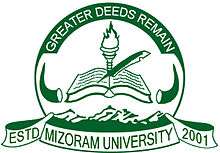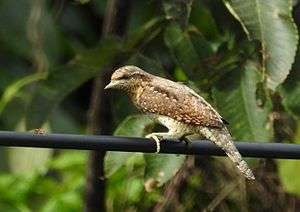Mizoram University
 | |
| Motto | Greater deeds remain |
|---|---|
| Type | Public university |
| Established | 2001 |
Parent institution | NEHU |
| Vice-Chancellor | Prof R. Lalthantluanga |
| Rector | Governor of Mizoram |
Academic staff | 232 |
| Location |
Aizawl, Mizoram, 796004, India 23°44′22″N 92°39′54″E / 23.7394°N 92.6651°E |
| Campus | Rural |
| Affiliations | UGC, AIU |
| Website |
www |
Mizoram University is a central university under the University Grants Commission, Government of India, and was established on July 2, 2001, by the Mizoram University Act (2000) of the Parliament of India.[1] The President of India is the official Visitor, and the Governor of Mizoram acts as the Chief Rector as per Mizoram University (Amendment) Bill, 2007.[2] According to the Act, the objectives of the university are "to disseminate and advance knowledge by providing instructional and research facilities in such branches of learning as it may deem fit, to make provisions for integrated courses in humanities, natural and physical sciences, social sciences, forestry and other allied disciplines in the educational programmes of the University; to take appropriate measures for promoting innovations in teaching-disciplinary studies and research; to educate and train man-power in the development of the state of Mizoram; and to pay special attention to the improvement of the social and economic conditions and welfare of the people of that State, their intellectual, academic and cultural development". Keeping these objectives in view, Mizoram University has embarked on various programmes for academic and administrative development.
History
The university is the fruit of the Mizoram Accord between Mizo National Front and Government of India on 30 June 1986.[3] However, it was not created de novo. The North Eastern Hill University, with its headquarters at Shillong had already run its Mizoram campus since 1978.[4] The Mizoram University Act by the Parliament of India officially established the school on July 2, 2001, incorporating all the facilities of the existing Mizoram campus of NEHU. The jurisdiction of the university therefore extends to the whole of Mizoram. Initially, the university had seven academic departments inherited from NEHU, but it now has a total of 18 academic departments. It hopes to bring the number to a total of 27 departments within the current Xth Plan. The university under NEHU functioned from various rented buildings in Aizawl for over two decades.
Campus

Mizoram University has changed immensely after the recent move of the main administration and some academic departments to its permanent campus at Tanhril, Aizawl. Except for a few remaining academic departments, the Sports Cell, the Medical Clinic and Central Library, the university is now well consolidated in its main campus. A plot of land measuring 978.1988 acres (395.8630 ha) with lush greenery and scenic hills, leased by the Government of Mizoram at Tanhril, serves as the permanent campus of Mizoram University.[5] It is now undergoing a sea change, thanks to the development and construction works taking place with the help of the sum of Rs. 25 crores from DoNER and anticipated commitment of UGC Grant for the Infrastructure of Development of Mizoram University under Xth Plan amounting to Rs. 43.50 Crores.
Forests and flora
The Mizoram University campus contains regenerating tropical wet evergreen and semi-evergreen forests, including a protected forested water catchment reserve in the north and a small biodiversity park. A number of streams flow through the campus. Setlak Lui (Lui = river in Mizo) runs along the valley and is joined by Rultawi Lui, Hratdawng Lui, Lalmangkhawng Lui, and Lungsumzau Lui. Kel Lui and Chengkawl Lui also flow through the area. These streams mostly flow in a north-westerly direction to join the Tlawng River.
The plant life includes 384 species of vascular plants in 290 genera and 107 families.[6] Common plants species include trees like Aporusa octandra, Castanopsis tribuloides, Schima wallichii, Bischofia javanica, and Anogeissus acuminata, shrubs like Melastoma nepalensis and Clerodedrum infortunatum, herbaceous plants like Imperata cylindrica, Erianthus longisetosus, Bidens biternata, and Knoxia corymbosa, and invasive alien species including Chromolaena odorata and Mikania micrantha. Bamboo species present include Melocanna baccifera, Dendrocalamus hamiltonii and Dendrocalamus longispathus.[6]
Animal diversity

The campus also has a rich diversity of animal species. Among reptiles, there are 23 species of snakes in four families, including Boiga cyanea, Elaphe porphyracea, Gonyosoma prasina, Pareas monticola, Rhabdops bicolor, Trachischium tenuiceps, Rhabdophis subminiatus, Trimerusurus erythrurus, Bungarus niger, Naja kaouthia, and Ophiophagus hannah.[7] The campus is noted as an eBird hotspot with about 50 species listed at present including species such as Eurasian Wryneck, Black-crested Bulbul and many others.[8] Mammals such as Hoary-bellied Squirrel and Pallas's Squirrel also occur.
Student life
Student Union
Mizoram University Students Council (MZUSC) is primarily responsible for building and preserving a healthy political culture in the campus. The Students Council holds Freshers to welcome new students and also a University festival called Vibrio.
Publication
Mizoram University has an Annual Magazine called Lunglohtui and a monthly newsletter called Silhouette published by the Department of Mass Communication.
Library
The library has barcode technology and an RFID library management system. Free online access is available though the Internet.
Sports
Mizoram University has a well equipped gym with football, basketball and table tennis facilities. An annual sports meet is held once a year in September. Mizoram University has a football team which has been champion of East Zone Inter University Tournament in 2008 and 2009, Runner up in 2010. Quarter finalist of all India Inter university football tournament in 2008 and 2010 and Champion in 2010.[9]
Accommodation
Mizoram University have two girls' hostel with a capacity of 100 and a girls' hostel with a capacity of 30. Four units of a boys' Hostel (capacity of 100) are available.
Schools and departments
- There are 8 schools and 35 departments functioning.
Constituent college
Pachhunga University College is the only constituent college of the university.[10] It is located toward the hub of Aizawl, at College Veng. It was established on 15 August 1958. It had been the constituent college of NEHU, and with the establishment of Mizoram University, the legal administration was automatically handed over to the new university. The college offers 19 subjects - 11 arts, seven science and one commerce. Annual enrolment of students averages 1280. There are 86 permanent teaching faculty.
Software Technology Park of India
Mizoram University has provided 5 acres of land to establish Software Technology Parks of India for which an MoU has been signed for a 66 year lease.[11][12]
Affiliates
At present, there are 31 undergraduate colleges, including 2 professional institutions and 1 constituent college. The total roll-strength in these institutions is approximately 87,500 students, excluding that of the constituent college.
|
|
References
- ↑ The Mizoram University Act of 25 April 2000
- ↑ "Further Discussion On The Mizoram University". http://indiankanoon.org. Retrieved 15 August 2012. External link in
|publisher=(help) - ↑ Mizoram Accord, 1986, Memorandum of Settlement
- ↑ NEHU Library
- ↑ "Introduction". Mizoram University Website. Retrieved 19 August 2012.
- 1 2 Lalchhuanawma (2008) Ecological studies on plant diversity and productivity of herbaceous species in Mizoram university campus at Tanhril, Aizawl, Mizoram (N.E. India). PhD Thesis, Mizoram University, Aizawl. http://hdl.handle.net/10603/1207
- ↑ Laltanpuia TC, Lalrinchhana C, Lalnunsanga, Lalrotluanga, Hmingthansanga R, Kumari A, Renthlei V, Lalrintluangi S, Lalremsanga HT (2008) Snakes of Mizoram University Campus, Tanhril, Aizawl with notes on their identification keys. Science Vision 8(4): 112-127. URL: http://www.sciencevision.org/current_issue/dl/Lalremsanga%20et%20al.%20Snakes%20Reptilia%20Serpentes%20of%20Mizoram%20University%20Campus%20Tanhril%20Aizawl%20with%20notes%20on%20their%20identification%20keys.pdf
- ↑ ebird. "eBird--Mizoram University Campus". eBird. Retrieved 2016-11-06.
- ↑ PC Lala. "MZU-in East Zone Inter University Football Tournament thleng dawn". Inkhel.com. Retrieved 8 November 2014.
- ↑ "The Pachhunga University College". PUC Website. Retrieved 15 August 2012.
- ↑ Technology Park of India "Signing of MOU for Software Technology Park of India" Check
|url=value (help). Department of Information & Communication Technology. Retrieved 5 September 2012. - ↑ "MoU signed for Software park in Mizoram". Assam Tribune. Retrieved 5 September 2012.
External links
| Wikimedia Commons has media related to Mizoram University. |
- Int. Scholarship: Link: www.daad.org/
- Official website